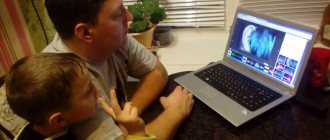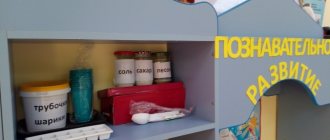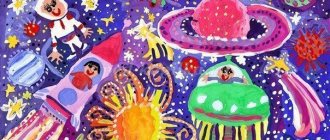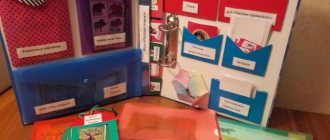Lesson “About volcanoes” for children
Experienced teachers have many ways to instill in a preschooler a love of science. These include working in a “children’s laboratory”, conducting scientific experiments, and simple experiments. By independently experimenting with substances and observing physical phenomena, children not only acquire knowledge about the world around them. They learn to think outside the box, exploratively, and can sometimes surprise with their logic.
One of the interesting topics about nature for children is volcanoes. The amazing world of these natural phenomena will not leave any child indifferent. And practical experience under the guidance of a teacher will delight even the most passive students.
Audience: preschoolers 5-6 years old
Props:
- Slides or posters about the structure of volcanoes, books about volcanoes for children, drawing sheets, pencils, markers, paints, brushes.
- Kit for conducting the experiment (basin or deep bowl, jar or bottle, water, cardboard, tape, soda, vinegar, dishwashing detergent, food coloring).
Progress of the lesson
The teacher begins the lesson with a riddle about a volcano:
-I throw stones, lava,
I am a dangerous giant!
Famous for its bad reputation.
What's my name? (Volcano)
- Children, today we will learn a lot of interesting things about volcanoes, what they are made of, how they sleep, erupt, and change the nature around them. In our laboratory we will conduct a magical experiment and see how lava flows out of a volcano, and at the end of the lesson we will have a quiz with questions about volcanoes. Do you love experiments and quizzes? At the end of the lesson, we will also play the game “Volcanologists”.
— What is a volcano? Maybe someone already knows?
This is a large natural mountain with a hole at the top from which hot streams pour out onto the surface of the earth.
— Where did the name Vulcan come from? The ancient people - the Romans - had a God of fire named Vulcan and he lived on the island of Vulcano in a country that is now called Italy. The god Vulcan commanded fire and lightning, and helped blacksmiths use fire to make objects from iron.
Here the teacher draws the attention of preschoolers to slides or posters about the structure of volcanoes.
—What does a volcano consist of? You and I already know that a volcano is a big mountain. It has a hole - a vent, from which hot, red-hot rock - lava - flows. The top of the vent is called a crater. It is located at the very top of the mountain. And below the mountain-volcano there is a huge cave with a hot substance called magma.
— Why do volcanoes erupt? Magma accumulates in the cave, begins to boil, rises up the vent and pours out onto the ground through the crater, turning into lava. Along with the magma, columns of smoke and volcanic ash erupt from the volcano, and hot stones fly. The whole earth around becomes gray and lifeless.
Physical exercise “Volcanic eruption”
- Let's imagine how a volcano erupts! Let's all sit on our haunches or on the floor. We are magma in an underground cave. Now let's start boiling and seething. We will splash our hands in the air and try to jump up. So the volcano is trembling, preparing to erupt. Now let our volcano burst out through the vent. Children jump up and raise their hands up. Magma poured out of the vent through the crater and spread over the ground, becoming lava.
Interesting facts about volcanoes
— And now interesting facts about volcanoes . They are active and dormant (extinct). Active volcanoes are those that have erupted in the last 10 thousand years and may still wake up and spew lava. Sleeping volcanoes will never wake up again. All volcanoes are studied by scientists - volcanologists; they are the ones who make predictions about what will happen next, whether the volcano will erupt or go dormant.
— The largest volcano on the planet, if you count the height from sea level, is Ojos del Salado . Its height is 6887 meters. It is located in South America and is considered dormant and extinct.
— The most dangerous volcano is located in Mexico, it is called Popocatepetl . Can you repeat this word? Volcanologists expect that he will someday wake up and erupt lava. Popocatepetl can kill a lot of people.
— In the Canary Islands there is a volcano on which a restaurant was built, and people cook food right on the fire of the volcano! They grill shish kebab and fish and treat the guests!
Now let's try to make a volcano erupt ourselves!
Children's laboratory experience
The teacher makes a model of the volcano in advance of the lesson or during the lesson with the children.
A basin or tray is placed on the table. This will be an island. The cardboard must be rolled into a cone and the seam sealed with tape or glue. The tip of the cone - cut off the crater with scissors. The cone can be coated with plasticine, so it will look like a real volcano. Place a bottle at the bottom of the basin under the cone, pour a tablespoon of soda into it, and pour in dishwashing detergent (25 ml). You can pour pebbles, sand into a basin around the mountain, and place animal figures. This way the picture will be more realistic.
In a mug, dilute food coloring (can be red or orange) with water and pour everything into a bottle under the volcano with the other ingredients. This way the magma will be ready.
And now the most important thing: pour vinegar into the mouth of the volcano and watch the eruption!
Here the teacher needs to be careful, it is important not to spill the vinegar and not allow the children to inhale this liquid.
Mixed with baking soda and dish soap in a bottle at the base of the volcano, the vinegar will create a rich foam from the volcano that will flow down the mountainside.
If you add baking soda and vinegar, the volcanic eruption can be repeated several times. Children will undoubtedly enjoy the spectacular experience.
After the experiment, it is advisable to ventilate the room.
Quiz
The quiz will help little researchers consolidate their acquired knowledge. Questions:
— Where did the name “volcano” come from?
— Which artisans did the god of fire help?
— What is the name of the hot substance in the cave under the volcano?
— What is the name of the long hole in a volcano through which magma rises?
- What is a crater?
— What does the magma that flows from the crater of a volcano turn into?
— What types of volcanoes are there?
—Who are volcanologists?
— What is the name of the largest volcano on the planet? Such a difficult word...
— What is the name of the most dangerous volcano?
Game "Volcanologists"
The most active participants in the quiz can be nominated as scientists - volcanologists. Let it be a girl and a boy.
Now you need to choose 3 - 4 strong boys who will firmly hold hands and form the mouth of a volcano. Their task is to hold their hands no matter what and not break the circle.
Volcanologists need to fill the volcano with magma. To do this, they call the rest of the participants into the mouth. A girl - a volcanologist - takes other girls by the hands and leads them into a circle - the mouth of a volcano. And the boy, a volcanologist, brings the boys, “pushing” them into the crater.
Circle - the muzzle stands firmly, without unclenching his hands. Children will have a lot of fun climbing into the circle and crowding around there; at this time the volcano is already seething, preparing to explode.
Everyone who did not fit into the crater can be called dinosaurs; they wander around the volcano. As soon as the vent overflowed, everyone who could entered the circle, the magma tore the vent - the volcano erupted, the children jumped out or fell out of the circle onto the floor. It's so fun!
Maybe now volcanologists themselves will choose an assistant and be the vent?
At the end of the lesson, the teacher invites the children to look at books about volcanoes for children with illustrations. Based on the knowledge they have acquired, children can themselves draw a volcano and the process of its eruption, using sheets of paper, paints, felt-tip pens, and pencils.
So, from the drawings in kindergarten, you will get an almost real scientific and educational exhibition about volcanoes for children.
Corrective effects of fairy tales
The fairy tale “Sandy Volcano” examines two opposing models of behavior of mom and dad in a situation when their child shows greed: encouragement and, conversely, teaching the child to interact with others.
Unfortunately, some parents are not alarmed by their child's greed. Moreover, some of them even encourage this behavior, believing that the baby values his goodness. In the fairy tale, this model of parental behavior is illustrated by the example of Mama-be-gemotikha, who considers her son to be thrifty, praises him and thereby encourages greed in him. But in fact, frugality has nothing to do with it. Seva the hippo does not take care of her things and does not value them. And this is not surprising - when a child receives things for nothing, the more they appear, the less he values them. So, a brand new toy may be broken after five minutes, and candy may be thrown away half-eaten. In fact, Seva’s behavior is driven by the desire to prevent someone else from taking possession of things. Because of this, he finds himself isolated - he has no friends at all. Having learned about this, Papa Hippo is very surprised. He decides to watch his son play with other animals himself. Hippo Dad understands that Hippo needs to be taught how to interact with others. He organizes the game “Sand Volcano” to unite Hippo and other animals. Hippo Dad teaches his son to share and cooperate with others. Through the metaphor of water droplets joining together, it demonstrates how important friendship is to achieving a common goal. At the end of the story, Mother Hippo notices that by communicating with others, her son becomes happier. She changes her attitude towards her son’s “frugality” and supports his desire to share the apple with Piglet. Mosina E.S. Why do clouds turn into clouds? Fairytale therapy for children and parents. - M.: Genesis, 2012. P. 87-93. Read other therapeutic tales Fairytale therapy for children
Types of volcanic structures
In general, volcanoes are divided into linear and central, but this division is arbitrary, since most volcanoes are confined to linear tectonic faults (faults) in the earth’s crust.
Linear volcanoes or fissure-type volcanoes have extensive supply channels associated with a deep split in the crust. As a rule, basaltic liquid magma flows out of such cracks, which, spreading to the sides, forms large lava covers. Along the cracks, gentle spatter shafts, wide flat cones, and lava fields appear. If the magma has a more acidic composition (higher silicon dioxide content in the melt), linear extrusive ridges and massifs are formed. When explosive eruptions occur, explosive ditches can appear tens of kilometers long.
The shapes of central-type volcanoes depend on the composition and viscosity of the magma. Hot and easily mobile basaltic magmas create vast and flat shield volcanoes (Mauna Loa, Hawaiian Islands). If a volcano periodically erupts either lava or pyroclastic material, a cone-shaped layered structure, a stratovolcano, appears. The slopes of such a volcano are usually covered with deep radial ravines - barrancos. Volcanoes of the central type can be purely lava, or formed only by volcanic products - volcanic scoria, tuffs, etc. formations, or be mixed - stratovolcanoes.
There are monogenic and polygenic volcanoes. The former arose as a result of a single eruption, the latter as a result of multiple eruptions. Viscous, acidic in composition, low-temperature magma, squeezed out of the vent, forms extrusive domes (Montagne-Pelé needle, 1902).
In addition to calderas, there are also large negative forms of relief associated with subsidence under the influence of the weight of erupted volcanic material and a pressure deficit at depth that arose during the unloading of the magma chamber. Such structures are called volcanotectonic depressions. Volcanotectonic depressions are very widespread and often accompany the formation of thick strata of ignimbrites—silicic volcanic rocks of various origins. They are lava or formed by sintered or welded tuffs. They are characterized by lens-shaped segregations of volcanic glass, pumice, lava, called fiamme, and a tuff or tofo-like structure of the main mass. As a rule, large volumes of ignimbrites are associated with shallow magma chambers formed due to the melting and replacement of host rocks. Negative relief forms associated with central-type volcanoes are represented by calderas - large round-shaped sinkholes several kilometers in diameter.
Post-volcanic phenomena
After eruptions, when the activity of the volcano either stops forever, or it “dormants” for thousands of years, processes associated with the cooling of the magma chamber and called post-volcanic processes persist on the volcano itself and its surroundings. These include fumaroles, thermal baths, and geysers.
During eruptions, a volcanic structure sometimes collapses with the formation of a caldera - a large depression with a diameter of up to 16 km and a depth of up to 1000 m. As the magma rises, the external pressure weakens, associated gases and liquid products escape to the surface, and a volcanic eruption occurs. If ancient rocks, and not magma, are brought to the surface, and the gases are dominated by water vapor formed when groundwater is heated, then such an eruption is called phreatic.
Lava that rises to the earth's surface does not always reach this surface. It only raises layers of sedimentary rocks and hardens in the form of a compact body (laccolith), forming a unique system of low mountains. In Germany, such systems include the Rhön and Eifel regions. In the latter, another post-volcanic phenomenon is observed in the form of lakes filling the craters of former volcanoes that failed to form a characteristic volcanic cone (the so-called maars).







